Cornus florida- The King of Spring
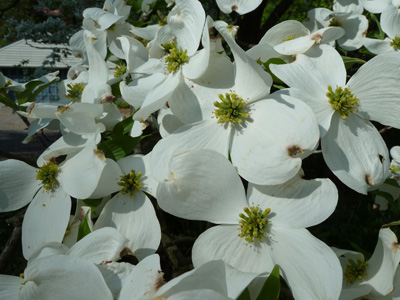 From birth through fifth grade I lived in a white two-story farmhouse. A thin strip of yard separated the house from the gravel road. Within that strip are two trees, a silver maple, Acer saccharinum and a flowering dogwood, Cornus florida. The two are an odd couple. The silver maple is a titan that towers above the house! My grandmother constantly worried that a windstorm would blow a branch down onto the roof. The dogwood, planted 50 feet away is of average height for its species yet seemed especially small in the shadow of the maple. A mental image of those two trees is forever etched in my mind, yet it is to the dogwood that I feel personally connected: we climbed its branches and hung yarn-tied plastic Easter eggs from its limbs. It served as “safe” during games of tag with my siblings and cousins, and was home to numerous home-made bird feeders. It dictated when it was time to plant corn, both field and sweet, as the wives tale instructed farmers to plant when the dogwood was in full bloom.
From birth through fifth grade I lived in a white two-story farmhouse. A thin strip of yard separated the house from the gravel road. Within that strip are two trees, a silver maple, Acer saccharinum and a flowering dogwood, Cornus florida. The two are an odd couple. The silver maple is a titan that towers above the house! My grandmother constantly worried that a windstorm would blow a branch down onto the roof. The dogwood, planted 50 feet away is of average height for its species yet seemed especially small in the shadow of the maple. A mental image of those two trees is forever etched in my mind, yet it is to the dogwood that I feel personally connected: we climbed its branches and hung yarn-tied plastic Easter eggs from its limbs. It served as “safe” during games of tag with my siblings and cousins, and was home to numerous home-made bird feeders. It dictated when it was time to plant corn, both field and sweet, as the wives tale instructed farmers to plant when the dogwood was in full bloom.
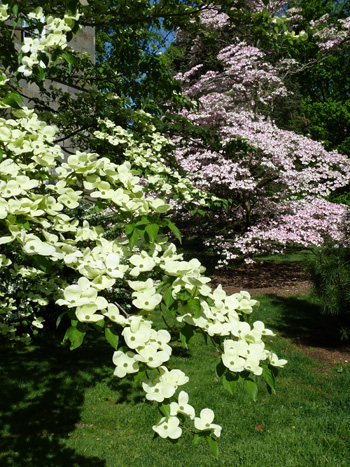
Cornus Celestial TM in bloom. photo credit: J. Coceano
The text Native Trees for North American Landscapes by Guy Sternberg with Jim Wilson gives high praise to the dogwood. The authors begin the entry as follows: “The king of spring in the Eastern United States and Southern Ontario, flowering dogwoods may be the most spectacular flowering tree native to our region. It grows slowly into a multilayered pagoda of color, its symmetrical branching pattern providing a sympodial crown of horizontal tiers…” Cornus florida is the state tree of both Virginia and Missouri and the state flower of North Carolina. Michael Dirr calls the flowering dogwood “The aristocrat of native flowering trees, often overplanted but never becomes obnoxious…”
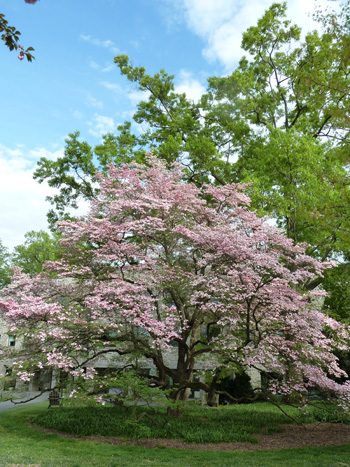
The wonderful pink blooms of Cornus florida var. rubra. photo credit: J. Coceano
Flowering dogwood can be found throughout the forests and woodland edges of Eastern North America from Toronto south to the Gulf Coast of Mexico and west to Eastern Texas. While the small tree has a broad range which encompasses many hardiness zones it is important to be mindful of provenance. A tree transplanted far from its native home region may not grow as well as one produced locally. When shopping for Cornus florida, attempt to obtain from a region with a similar climate and soil type.
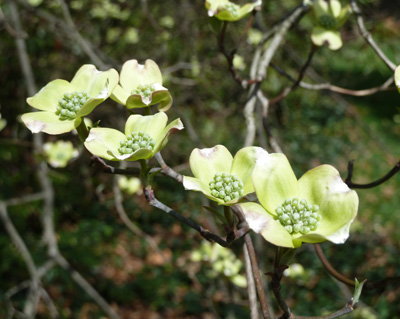
Cornus florida bracts beginning to expand. photo credit: J. Coceano
Simple, opposite leaves appear after flowering. Quarter-inch greenish-yellow flowers, typically appearing at the end of stems, are surrounded by four white bracts. Bracts initially emerge greenish-white before transitioning to white as the bracts expand. Bracts, opening in April to May, remain showy for about two weeks. Red to reddish purple color develops in the fall. Clusters of glossy red ovoid fruit ripen in September and October. Fruit can persist throughout the winter until consumed by overwintering birds. Bluebirds are particularly fond of the fruit. Pebbled gray bark develops as trees age.
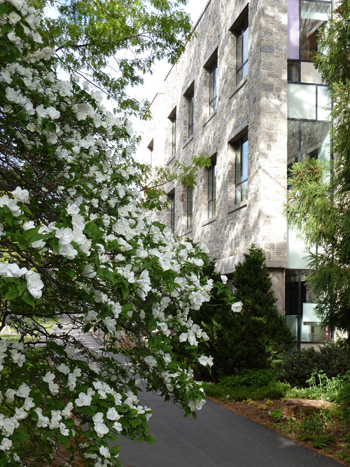
Cornus florida 'Pluribracteata' in the dabbled sun along Kohlberg Hall. photo credit: J. Coceano
The flowering dogwood is not without its share of pests. Dogwood anthracnose, a relatively recent disease, became a widespread problem in the 1980s. It was feared the disease could be the next chestnut blight. While populations are affected, particularly those in high-elevation forests or specimens grown in urban and suburban landscapes in soil of poor quality, it has not become the devastating disease pathologists feared. Proper culture is the best defense against the fungus. Other ailments include cankers, root rot, and powdery mildew. Meager growth can often be attributed to poor site selection. Consider a flowering dogwood if you can mimic its natural growing conditions. Cornus florida thrives in settings where leaves are exposed to sun and roots are in the cool shade. Air flow helps keep anthracnose at bay. Avoid compacted and poorly draining soils. Lastly, don’t over-fertilize.
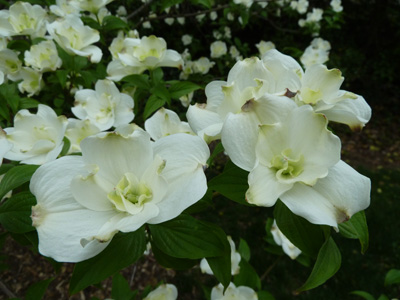
The unique blooms of Cornus florida 'Pluribracteata'. photo credit: J. Coceano
Both Thomas Jefferson and George Washington planted dogwoods around their estates. Since that time other selections of C. florida have been recorded. Many have been introduced as a result of selecting and breeding for disease-resistance. Dozens of selections and cultivars are available. The cultivar ‘Appalachian Spring’ is well-known for being the progenitor of other disease-resistant cultivars. In a stand of dogwoods devastated by anthracnose stood one lone tree. Resulting from that single tree and breeding work by the University of Tennessee came C. florida ‘Appalachian Spring’. Hybrids, crosses of Cornus florida and C. kousa have been released by Rutgers, the State University of New Jersey. The six hybrids demonstrate increased vigor, disease resistance, and highlight the best attributes of each species.
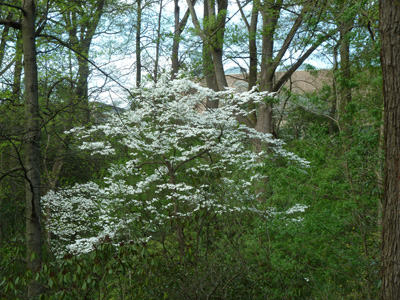
Cornus florida is putting on a show behind the Scott Outdoor Ampitheater. photo credit: J. Coceano
How did such a beautiful tree end up with a rather lousy common name? According to a fact sheet released by North Carolina State University several possible explanations exist. In Europe the bark from a similar looking plant dubbed dogwood was used to cure the mange. Early colonists may have scoffed at the plant calling it “dog tree” or “dog wood” for the pitiful fruits. Lastly, the name may originate from dagwood, dag being the name for skewer, a possible use of the durable wood.
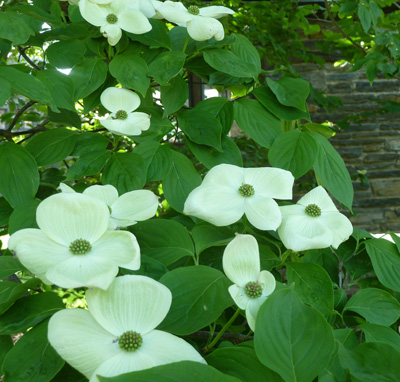
The large blooms of Cornus Aurora (R). photo credit: J. Coceano
The Scott Arboretum has a diverse collection of both native and non-native cornus. My personal favorites include the cultivars ‘Appalachian Spring’, ‘Pluribracteata’ with its long-lasting double white flowers, and Aurora®, a Rutgers introduction, with rounded bracts that slowly age to a creamy white. Several pink and rose colored selections are available as well.
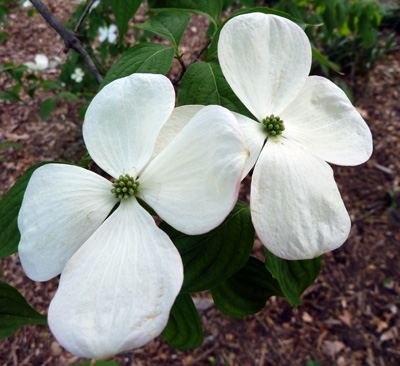
Another great selection Conrus florida 'Ruth Ellen'. photo credit: J. Coceano
So what now of the silver maple and dogwood? My sister and her family now live in the farmhouse. Bird feeders, nephews, and plastic Easter eggs still dangle from the dogwood’s branches. I hope you have a tree that stirs up such good memories. If not, consider planting a flowering dogwood.





Jos Zost
Posted at 22:20h, 18 MayThank you for the Cornus Florida info. I wonder if you could help me locate a source where I could purchase a Cornus Florida f. rubrum. It should have pink flowers with horizontal branching. Thank you!